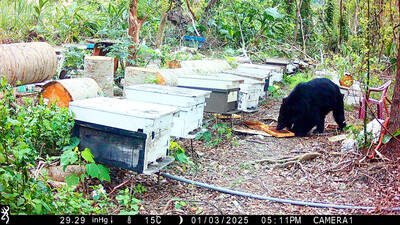In an apparent move to alleviate the concerns of Aborigines, farming, logging and land development on mountainous areas higher than 1,500m will be banned, except for those in Aboriginal settlements, according to a special bill on land conservation approved by the Executive Yuan yesterday.
Four state-run farms located on mountainous areas would have to go fallow within three years.
Under the special draft bill on land restoration and conservation (
Category one areas are those higher than 1,500m, where farming, logging and land development will be banned.
Farmland must be allowed to go fallow and existing buildings or facilities will have to be demolished within five to 15 years.
Certain exceptions will be allowed, however. These include Aboriginal settlements with more than 30 families, facilities for conservation, study or tourism, Aboriginal historical relics, defense facilities and public facilities.
Category two would cover mountainous areas between 500m and 1,500m. New farming or new developments will be banned, but existing legal operators will be allowed to remain.
Category three areas include mountainous areas lower than 500m. Any land developments must be based on sustainable development and local governments are required to regularly review their development policies and obtain permission from the central government for developing land.
The draft also recommends spending NT$100 billion over the next 10 years on land restoration projects.
The fund would help Aboriginal settlements that are willing to relocate in a group. The draft stipulates that the central government should find a new place for them to live and help them with employment, education and preserving their traditions and culture.
While some have argued that the bill will jeopardize the livelihoods of Aboriginal people, Chang Ching-sen (
"Statistics show that 99 percent of Aborigines live in mountainous areas lower than 1,500m," he said.
Chang also dismissed talk that compromises had been made during the drafting process.
"There's no compromise. I'd rather call it negotiation, if anything," he said. "Some might have the wrong impression that the bill is not welcomed by the Aboriginal people. Apparently, they've been misled by certain political parties and false media reports."
If the bill passes the legislature, Chang made it clear that the government will not send any more money to fix the damaged section of the Central Cross-Island Highway because of its fragile geology.
Chang, however, said the government will continue to push for construction of a freeway connecting Ilan and Hualien. The project has been criticized by environmental groups as being damaging to the environment.

SHIPS, TRAINS AND AUTOMOBILES: The ministry has announced changes to varied transportation industries taking effect soon, with a number of effects for passengers Beginning next month, the post office is canceling signature upon delivery and written inquiry services for international registered small packets in accordance with the new policy of the Universal Postal Union, the Ministry of Transportation and Communications said yesterday. The new policy does not apply to packets that are to be delivered to China, the ministry said. Senders of international registered small packets would receive a NT$10 rebate on postage if the packets are sent from Jan. 1 to March 31, it added. The ministry said that three other policies are also scheduled to take effect next month. International cruise ship operators

NUMBERS IMBALANCE: More than 4 million Taiwanese have visited China this year, while only about half a million Chinese have visited here Beijing has yet to respond to Taiwan’s requests for negotiation over matters related to the recovery of cross-strait tourism, the Tourism Administration said yesterday. Taiwan’s tourism authority issued the statement after Chinese-language daily the China Times reported yesterday that the government’s policy of banning group tours to China does not stop Taiwanese from visiting the country. As of October, more than 4.2 million had traveled to China this year, exceeding last year. Beijing estimated the number of Taiwanese tourists in China could reach 4.5 million this year. By contrast, only 500,000 Chinese tourists are expected in Taiwan, the report said. The report

The Forestry and Nature Conservation Agency yesterday launched a gift box to market honey “certified by a Formosan black bear” in appreciation of a beekeeper’s amicable interaction with a honey-thieving bear. Beekeeper Chih Ming-chen (池明鎮) in January inspected his bee farm in Hualien County’s Jhuosi Township (卓溪) and found that more than 20 beehives had been destroyed and many hives were eaten, with bear droppings and paw prints near the destroyed hives, the agency said. Chih returned to the farm to move the remaining beehives away that evening when he encountered a Formosan black bear only 20m away, the agency said. The bear

Chinese embassy staffers attempted to interrupt an award ceremony of an international tea competition in France when the organizer introduced Taiwan and displayed the Republic of China flag, a Taiwanese tea farmer said in an interview published today. Hsieh Chung-lin (謝忠霖), chief executive of Juxin Tea Factory from Taichung's Lishan (梨山) area, on Dec. 2 attended the Teas of the World International Contest held at the Peruvian embassy in Paris. Hsieh was awarded a special prize for his Huagang Snow Source Tea by the nonprofit Agency for the Valorization of Agricultural Products (AVPA). During the ceremony, two Chinese embassy staffers in attendance